Sure Dividend Review 2024: Is it Worth the Cost?
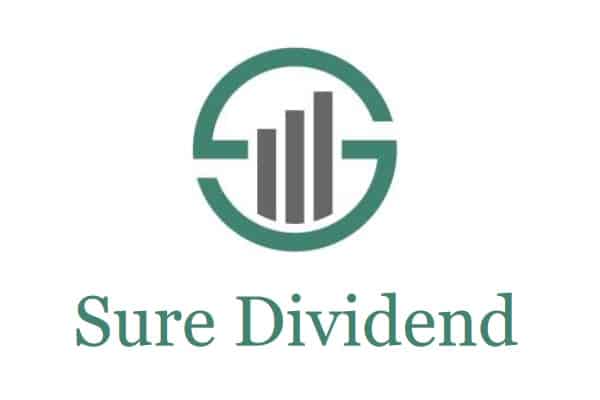 This Sure Dividend review was updated on 01/01/2024.
This Sure Dividend review was updated on 01/01/2024.
Sure Dividend is an investing website and paid newsletter service focusing on dividend stocks and income investing.
When the Sure Dividend blog started in 2014, it built a significant audience by providing in-depth analyses of stocks on the Dividend Aristocrats list.
The Aristocrats are S&P 500 index stocks that have paid and increased dividends for the past 25 years or more.
Sure Dividend has expanded its research circumference to more than 850 stocks and now offers multiple paid newsletters providing stock recommendations for income investors.
Unlike popular newsletters such as Motley Fool Stock Advisor, Sure Dividend favors dividend security, dividend growth, and total return rather than disruptive growth stocks.
The Sure Dividend Newsletter is its flagship premium newsletter. It is the primary focus of this Sure Dividend review.
The flagship newsletter is now bundled as part of the Sure Dividend Pro Plan with four other newsletters: The Sure Retirement Newsletter, The Sure Passive Income Newsletter, The Top 10 Dividend Elite Service, and The Top 10 REITs Service (real estate investment trusts).
I’ve been a paying subscriber of Sure Dividend for more than four years. I use the various services to help narrow the universe of dividend stocks that I consider for my portfolio.
It’s worth the cost to me. This article explains why.
There’s also a new lower-tier plan called the Sure Dividend Ideas Plan that offers basic stock and REIT recommendations through the Top 10 Dividend Elite and Top 10 REITs Services only.
Pricing for both plans and exclusive discounts for RBD readers is detailed below.
Sure Dividend has grown from a humble blog to one of the most recognized stock newsletters for income-focused investors.
The company now has more than 9,000 premium members.
Table of Contents
Who Is Sure Dividend For?
Sure Dividend’s target audience is investors looking to build passive income through dividend stocks.
These investors tend to be closer to retirement age (50+), but the service may also appeal to younger long-term dividend investors interested in passive income.
Market Index funds are sufficient for most people — investors do not need to buy individual stocks.
However, the total market and blue-chip index funds typically yield below 2%.
For those looking to increase the income yield on their investment dollars, buying individual dividend stocks can do the job.
Therefore, the Sure Dividend Newsletter and other products are best suited for those looking beyond index funds and bonds to generate reliable retirement income and dividend growth.
The Sure Dividend Pro Plan is recommended for “intelligent investors with $50,000+ portfolios”. It is the best value for subscribers.
The Sure Dividend Ideas Plan is designed for “intelligent investors with $10,000+ portfolios and those just starting their dividend growth journey.”
Sure Dividend Review 2024 Walkthrough
The Sure Dividend Newsletter is a 50+ page PDF sent to your email every month. The newsletter arrives in the morning on the first Sunday.
When I receive mine, I usually read the opening article, check out the Top 10 List, then flag the email and return to it when I’m researching stocks at my computer.
Each month, the newsletter contains ten stock recommendations and more than 850 dividend security and risk rankings.
In this section, I’ll quickly go over pricing and then walk through the monthly newsletter sections. More detailed pricing is below.
Note: Screenshots are taken from the August 2020 version of the newsletter to avoid revealing recent proprietary information. The data is outdated, but you’ll see how the newsletter is structured.
You can try the Sure Dividend Pro Plan for a 7-day trial to get the latest versions and cancel if you don’t like it. You won’t be charged until after the 7-day trial is complete. Cancel your subscription at any time.
The regular price for the Sure Dividend Pro Plan is $499. RBD readers pay $399 per year by using the button below or the Sure Dividend coupon code “RBD100S“.
Opening Thoughts
Each monthly edition begins with an opening article about current market conditions, dividend investing basics, advanced analysis, or a look at historical data.
Most have a chart or data table included.
Some recent Opening Thoughts articles include:
- The Dividend Kings & COVID-19
- Buying When Others Are Selling
- Did the U.S. Stock Market Underreact to the COVID-19 Pandemic?
- Why Invest In Dividend Stocks?
- Examining Our Sell Recommendations
- The Market’s Valuation Now
- On Payout Ratios
These are insightful and no more than 400 words — easy to absorb Sunday morning.
The Sure Dividend Top 10 List
The next section is undoubtedly the most popular, the Sure Dividend Top 10 List.
Here’s how it looks. Note: These recommendations are from August 2020 and are shown for illustrative purposes.
Some of the key fields in the Top 10 List include:
- Dividend Risk Score – A proprietary rating on dividend safety
- Dividend Yield
- Payout Ratio – A favorite metric for dividend investors, the percentage of earnings paid to shareholders
- Expected Growth – The expected annualized dividend growth rate
- Expected Total Return (ETR)
Some of these values are actual (e.g., price, yield); others are derived from data and analysis (e.g., ETR).
At the bottom, there’s an equal-weighted Top 10 List comparison to owning the S&P 500 via SPY.

If you follow the Sure Dividend investing method over time, you can expect to earn a higher dividend yield than the SPY. Expected returns are no guarantee of future results.
The Top 10 List is an excellent place to start if you’re looking for new investment ideas. Pick your favorite and complete due diligence, or follow the Portfolio Buying Guide (below) to diversify your portfolio over time.
Analysis of Top 10 Securities
The next section is a deep dive into each of the Top 10 List stocks, usually three pages long per recommendation. The deep dive includes a narrative, financial statement data tables, and a dividend yield history chart.
That’s 30 pages of analysis.
For this section, the screenshots come from the August 2020 edition and the Walgreens Boots Alliance (WBA) recommendation.
Analysis Narrative
The analysis begins with a page-long narrative that includes:
- Overview & Current Events
- Competitive Advantages & Recession Performance
- Growth Prospects, Valuation, & Catalyst
The narrative explains the conviction, which includes quantitative and qualitative data points.
At the bottom, there’s a data table with key statistics, ratios, and metrics to support the conviction.
Here is the Walgreens Boots Alliance table in the August 2020 edition.

Financial Data Tables
Next, are three tables displaying ten years of data. The tables are Income Statement metrics, Balance Sheet metrics, and Profitability and Per Share metrics.
I don’t use these tables much for my research, but I find them interesting to see long-term trends.
Dividend Yield History Chart
Finally, there is a dividend yield history chart for each stock in the Top 10 List. I like this chart because it shows, in one view, the correlation between price and yield.
Recommendations often point to a recent divergence, which may indicate a value opportunity.
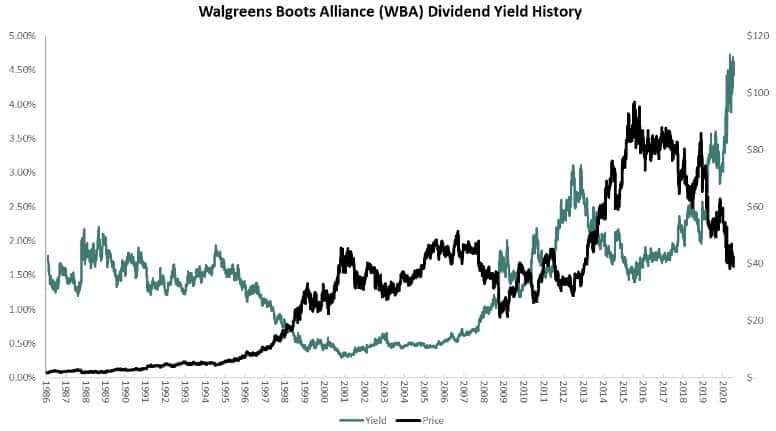
When the price goes down, the yield rises, a fundamental dividend investing concept.
Dividend investors can achieve higher yields by seeking lower prices, and maximizing income from investment dollars when the stocks are toward low historical valuations.
Combined with dividend safety, qualitative analysis, and many of the metrics laid out in the data table, investors can build confident positions that are likely to continue to pay and grow dividends over time.
Closing Thoughts
The Closing Thoughts page is similar to the Opening Thoughts section. They are sometimes longer but often contain a chart to support the story.
Every month, the Closing Thoughts section finishes by announcing when the next issue will reach your email and an investment advice disclaimer.
Real Money Portfolio
In the January 2019 edition of the Sure Dividend Newsletter, the service started a real-money portfolio to buy their recommendations and track the performance over time.
Each month they invest $1,000 in the highest-ranked security in the Top 10 List that they either don’t own or own the least amount.
The real-money portfolio is designed to show the progress of building and maintaining a dividend growth portfolio using the Sure Dividend Method.
They do not buy stocks that push the portfolio over 30% in any one sector to prevent over-concentration and maintain diversification.
The portfolio will hold 30 securities max. Once the portfolio reaches 30 securities, it will buy the highest-ranked security already in the portfolio, up to 10% of its value.
Sell criteria are the same as recommendations in the newsletter.
Dividend investing is often more about income than total return.
The yield and value of the portfolio holdings are highlighted clearly, but it does not compare annualized returns to the S&P 500 returns over the portfolio’s life.
Better performance data to include portfolio compound annual growth rate (CAGR) would be an area for improvement for this section.
Buying & Ranking Criteria
The Buying & Ranking Criteria page has been consistent over many editions of the Sure Dividend Newsletter.
Here’s how Sure Dividend chooses its Top 10 List:
- Filter our Sure Analysis Research Database universe of securities for:
- 10%+ Expected Total Returns
- A & B Dividend Risk Scores
- U.S. securities only (no international securities, REITs, MLPs, or BDCs, etc.)
- All companies must have their dividend covered by cash flows
- Sort by Expected Total Returns (highest first)
- No more than three companies per sector
- Veto any securities from the Top 10 List as necessary after qualitative analysis
- The Top 10 List is the 10 highest Expected Total Returns securities from steps 1 through 4
- “A” Dividend Risk Score securities rank ahead of “B” Dividend Risk Score securities within the Top 10 List
To receive an “A” Dividend Risk Score, a security must be in the top 20% for dividend safety. To receive a “B” Dividend Risk Score, a security must be in the top 40% for dividend safety.
The formula for the Dividend Risk Score is below:
Dividend Risk Score (Raw) = Payout Ratio x 100 – # Years of Steady or Rising Dividends + 50We view securities with “A” and “B” Dividend Risk Scores as generally having secure dividends that are very unlikely to be reduced in the near future.
Portfolio Building Guide
I use the Sure Dividend Newsletter primarily for idea generation and risk rankings. But the service also offers a buying guide for investors looking for a basic strategy to buy recommended stocks.
The strategy is simple.
Buy the top-rated stock in the Top 10 List that you don’t currently own. If you already own all ten, buy the stock you own the least.
Here’s the illustration for August 2020:
Past Recommendations & Sells
The next section contains a large table with the sold and unsold previous recommendations from the past 6+ years. Performance is measured against the S&P 500 using the SPY index ETF.
Sell recommendations are not included in the Sure Dividend Ideas Plan.
This table gives a clear view of how the individual recommendations have performed by Total Return and CAGR. It also includes an updated dividend risk score and 5-year expected returns.
Regarding sales, the Sure Dividend Newsletter has two sell rules.
Sell Rule #1 — Dividend-Based Sell Rules: Any past recommendation that reduces or eliminates its dividend is automatically a pending sell. We review and analyze these securities to determine when to initiate the final sale. Secondly, any past recommendation with an “F” Dividend Risk Score is reviewed as a potential sell.
Sell Rule #2 — Valuation-Based Sell Rules: Sell past recommendations with expected total returns below the expected total returns of the S&P 500 over the next several years. This sell rule replaces our previous valuation-based sell rule of selling securities with an adjusted P/E ratio of 40 or higher.
Newsletter authors issue a “pending sale” for stocks before issuing a final sell recommendation. After a stock has a pending sale, they advise waiting for a reasonable exit price closer to fair value.
Sell recommendations are one area that is less aligned with my dividend investing strategy.
Looking over the list of recent sales, I see several high-quality dividend growth stocks and Dividend Aristocrats that I still own and have appreciated significantly since the sell date.
I won’t cherry-pick the list. But in general, as someone who has aimed to own high-quality companies for decades, I use the sell recommendations as another data point in my portfolio maintenance analysis, but I do not follow it.
The Sure Dividend Passive Income Newsletter focuses more on buy-and-hold forever stocks.
List of Securities by Dividend Risk Score and by Sector
The Dividend Risk Score section lists all 600+ stocks in the Sure Dividend Research Database and ranks them.
It groups stocks into five risk ratings, A, B, C, D, and F.
The top 120 safest stocks are in group A. The next 120 safest stocks are in group B, and so on.
Within each group, the list is sorted by Expected Total Returns. These rankings don’t necessarily align with the Top 10 List, which considers sectors and qualitative analysis.
The next section breaks the rankings a step further by sector.
The sector lists help generate investment ideas for safe stocks if you’re looking to bulk your portfolio’s exposure to a specific sector.
Pick a sector and choose a low-risk stock for further research. Or search the PDF for any dividend stock symbol to find where it ranks among similar companies.
The eleven sectors are:
- Basic Materials
- Communication Services
- Consumer Cyclical
- Consumer Defensive
- Energy
- Financial Services
- Healthcare
- Industrials
- Real Estate
- Technology
- Utilities
Pros: Sure Dividend Newsletter
The Sure Dividend Newsletter is a supplemental research tool. Use it to avoid investing alone, but don’t solely rely on it for stock purchases.
Like any recommendation or newsletter, it’s not a replacement for due diligence.
If you’re investing thousands of dollars a year in individual stocks, it helps to have a second opinion beyond free internet content.
The Top 10 List is the premium content. It highlights the cream of the crop, narrowing your search for investable new holdings.
Sure Dividend uses a structured rules-based approach, so you don’t have to build your own methodology to find new ideas.
The Dividend Risk Score is another pro because any time you are looking to buy a high-quality dividend stock, it’s likely in the 600+ list.
Check the risk score before deploying capital. If it’s below a C, you may find a more suitable best-of-breed stock in the same sector.
Finally, the Sure Dividend team consists of multiple finance writers who do this for a living, bringing you insightful articles from different perspectives that are easy to digest.
Cons: Sure Dividend Newsletter
The sell rules have been a bit aggressive for my taste since late 2018. Most successful dividend investors hold for decades, not years. They do not like selling excellent companies, even if they’re going through tough times.
It appears Sell Rule #2 was recently updated, so we’ll see if they continue to recommend selling top-notch stocks due to high valuations.
In the Analysis of Top 10 Securities, the financial data table is a data dump rather than an additional analysis. Though it’s interesting to view trends, the Analysis Narrative and Dividend Yield History Chart are more useful.
Finally, I’d like to see better performance transparency in the Real Money Portfolio section. This would tell a new investor if following their portfolio-building strategy is working.
Later in the newsletter, individual stock recommendation price performance data is listed, but not as much for the Real Money Portfolio.
As a portfolio-building guide, there’s more story to be told for potential followers.
Dividend investing is different than the Motley Fool newsletter strategies (disruptive growth), so investors should not expect comparable returns.
But the Fool is more meticulous and transparent about the performance of the entire portfolio of recommendations over time.
Sure Dividend could implement similar performance reporting for better transparency. But with ten recommendations per month, it’s a more tedious effort to track them all.
Sure Dividend Pro Plan Pricing
Here’s everything you get with the Sure Dividend Pro Plan:
The Sure Dividend Newsletter — The Sure Dividend flagship newsletter focuses on high-quality dividend growth stocks trading at fair or better prices. It publishes on the 1st Sunday of the month. It includes each section as described in this Sure Dividend review.
The Sure Retirement Newsletter — Focuses exclusively on securities with 4%+ dividend yields, including stocks, REITs, MLPs, and BDCs. It publishes on the 2nd Sunday of the month.
The Sure Passive Income Newsletter — Focuses on ‘buy and hold forever’ dividend stocks. Its goal is to buy once and never sell for truly passive rising income over the long run. It publishes on the 3rd Sunday of the month.
Top 10 Dividend Elite Service — Analyzes the Top 10 dividend stocks with 25+ years of rising dividends every month. It publishes on the 1st Sunday of the month.
Top 10 REITs Service — Analyzes the Top 10 REITs every month. It publishes on the 2nd Sunday of the month.
The regular price of the Sure Dividend Pro Plan is $499.
Use the button or the Sure Dividend coupon code “RBD100S” to save $100 annually and get the discounted price of only $399 per year.
You can try the Sure Dividend Pro Plan for a 7-day trial to get instant access to the newest newsletters. You won’t be charged until after the 7-day trial is complete.
Please note: RBD is an affiliate partner with Sure Dividend. If you sign up for a service using links on this page or use the Sure Dividend coupon code “RBD100S”, RBD will be compensated.
Sure Dividend Ideas Plan Pricing
The Sure Dividend Ideas Plan is a limited plan that offers two newsletters per month.
The included newsletters are the Top 10 Dividend Elite Service and the Top 10 REITs Service, which are also included in the Sure Dividend Pro Plan.
Sure Dividend Ideas Plan subscribers do not get access to the Sure Dividend Newsletter (flagship), Sure Retirement Newsletter, or the Sure Passive Income Newsletter.
The regular price of the Sure Dividend Ideas Plan is $99 per year.
Use the button below or the Sure Dividend coupon code “RBD32S” to save $32 annually and get the discounted price of only $67 per year.
You can try the Sure Dividend Ideas Plan for a 7-day trial to get instant access to the newest newsletters.
You won’t be charged until after the 7-day trial is complete.
What makes the Sure Dividend Pro Plan different from the Sure Dividend Ideas Plan is the Pro Plan’s newsletters include sell recommendations on past picks and portfolio-building guides. Whereas the Dividend Ideas Plan only includes buy recommendations.
Please note: RBD is an affiliate partner with Sure Dividend. If you sign up for a service using links on this page or use the Sure Dividend coupon code “RBD32S”, RBD will be compensated.
Sure Dividend Review: Additional Newsletters
As stated in the introduction, this Sure Dividend review focuses primarily on the flagship Sure Dividend Newsletter, which is one of five components of the Sure Dividend Pro Plan.
The other newsletters in the bundle follow a similar format tailored to the specific investment objectives.
Here is more information about the other newsletters in the Sure Dividend Pro Plan bundle.
The Sure Retirement Newsletter
This product uses data from the Sure Analysis Research Database to find and rank quality dividend growth stocks with 4%+ yields — so you invest in high-yield dividend growth stocks trading at fair or better prices.
Each month you get the Top 10 best 4%+ yielding quality income securities, plus actionable buy and sell recommendations and a portfolio-building guide.
Specifically, The Sure Retirement Newsletter recommends securities that generally have the following characteristics:
- 4%+ yields only (often higher)
- Securities likely to pay steady or rising dividends into the future
- Securities trading at or below fair value
- Securities with strong expected total return potential
Besides focusing on higher yields, the main difference from the Sure Dividend Newsletter is the Sure Retirement Newsletter also recommends REITs and master limited partnerships (MLPs, both explained in this guest post by Sure Dividend writer Bob Ciura).
The Sure Dividend Newsletter yields are typically lower than 4% on average but demonstrate higher long-term growth.
The Sure Dividend Passive Income Newsletter
The stocks recommended in The Sure Passive Income Newsletter are meant to be purchased once and never sold.
Steady income and income growth are key components of financial freedom through passive income.
Rising passive income provides the base for a safe and secure retirement because income growth counteracts the wealth damaging-effects of inflation.
The newsletter prioritizes growth and long-term safety, with dividend yields that exceed the S&P 500’s for each recommendation.
The Sure Passive Income Newsletter has everything you need to build your rising passive income portfolio, including a detailed analysis of the Top 10 ‘forever’ passive income stocks each month and a to-the-point portfolio-building guide.
Top 10 Dividend Elite Service
This service provides recommendations on the Top 10 dividend stocks each month with 25+ years of rising dividends. It publishes on the 1st Sunday of the month.
The Dividend Elite Service is part of the Sure Dividend Ideas Plan and Sure Dividend Pro Plan.
This newsletter has less detail and quantitative analysis than the Sure Dividend Newsletter. It provides ten recommendations and a narrative of the investment thesis of each.
But is lighter on data and charts, excludes opening and closing thoughts, and sell recommendations.
Top 10 REITs Service
The Top 10 REITs Service analyzes the Top 10 REITs every month. It publishes on the 2nd Sunday of the month.
It is included in both the Sure Dividend Ideas Plan and Sure Dividend Pro Plan.
The newsletter has a similar format to the Top 10 Dividend Elite Service but focuses exclusively on real estate investment trusts (REITs).
The Sure Analysis Research Database
The Sure Analysis Research Database includes timely, detailed analyses of over 850 dividend stocks.
The service provides detailed total return estimates for each stock. It ranks all stocks by expected total returns — giving you the power to see the highest expected total return dividend stocks at any time and avoiding the worst.
It also includes a portfolio tracking tool. Import your stock portfolio symbols and share numbers to know exactly how much dividend income you will receive each month and year.
I highly recommend this tool, its the best dividend tracking spreadsheet I’ve ever used.
Sure Dividend formats the database into a spreadsheet, making it easy for users to edit and manipulate.
The Sure Analysis Research Database subscription also includes access to all five premium newsletters.
The price is $999 annually. There may be a waitlist to join.
Sure Dividend Review 2024: Is it Worth the Cost?
Sure Dividend is an excellent resource for income investors looking to build stable dividend income for retirement.
New investors just getting started should first consider whether index investing is sufficient for their needs.
Individual stock investing requires additional research beyond a newsletter Top 10 list. Before owning individual stocks, decide if you have the time and knowledge to perform the necessary research.
If you do, I recommend stock newsletters for investing inspiration and additional data points for your research.
The Sure Dividend Newsletter is best for those investing at least $5,000 per year into individual dividend stocks.
You can also visit the archives for hundreds of free articles and helpful lists.
The regular price to subscribe to the Sure Dividend Pro Plan is $499. RBD readers pay $399 per year. Use the button below or Sure Dividend coupon code RBD100S.
The Sure Dividend Golden Rule Commitment
- 7-Day Free Trial – You aren’t billed for seven days.
- 60-Day Full Refund Grace Period – If the Sure Dividend Services are not right for you anytime during the first 60 days from the date you joined, email them, and you will receive a full refund; no explanation is needed.
- Prorated Refunds After 60 Days
- Pre-Billing Renewal Notifications – They will email you five days before your plan’s annual renewal, so you are never surprised with a renewal payment.
- Top-Notch Customer Service
Thanks for reading this Sure Dividend review 2024.
Are you a subscriber? Please share your experience with the Sure Dividend Newsletters in the comments below.
Sure Dividend Newsletter Review
-
Ease of Use - 9.5/10
9.5/10
-
Diversification - 9.5/10
9.5/10
-
Transparency - 9/10
9/10
-
Cost - 9/10
9/10
-
Value - 9.5/10
9.5/10
Summary
The Sure Dividend Newsletter is a PDF emailed to your inbox on the first Sunday of every month. It provides ten stock recommendations in each edition and risk ratings on 850+ dividend stocks. The flagship newsletters is one of 1 newsletters included with the Sure Dividend Pro Plan. For $399 per year (use Sure Dividend coupon code RBD100), it’s worthwhile for those investing more than $5,000 per month into individual dividend stocks. The newsletter could do a better job of tracking past recommendations for its Real Money Portfolio. Like other stock subscription services or advice, individual due diligence is still imperative before acting on recommendations. The Sure Dividend Ideas Plan contains just two of the five newsletters available in the Pro Plan, and is designed for beginner to intermediate investors just getting started with dividend investing. The Sure Dividend Ideas Plan is $67 per year if you use links on this web page or Sure Dividend coupon code RBD32.
Note: The recommendations provided by Sure Dividend do not reflect the opinions of RBD. Please perform research before investing your money into these or any other investments. Do not invest money into stocks that you cannot afford to lose. Invest at your own risk. You may lose some or all of your capital invested.
* Also note: RBD partners with brands and services that you may find useful in your own investing endeavors. As always, I only partner with brands and services I use or have fully vetted and endorse. I’m a paid subscriber of, and, separately, an affiliate partner with Sure Dividend. If you become a paid subscriber through one of the links or buttons in this article, RBD will be compensated for the referral. Thank you for supporting this website.
Disclosure: The author is long BMY, WBA, T

Craig is a former IT professional who left his 19-year career to be a full-time finance writer. A DIY investor since 1995, he started Retire Before Dad in 2013 as a creative outlet to share his investment portfolios. Craig studied Finance at Michigan State University and lives in Northern Virginia with his wife and three children. Read more.
Favorite tools and investment services right now:
Sure Dividend — A reliable stock newsletter for DIY retirement investors. (review)
Fundrise — Simple real estate and venture capital investing for as little as $10. (review)
NewRetirement — Spreadsheets are insufficient. Get serious about planning for retirement. (review)
M1 Finance — A top online broker for long-term investors and dividend reinvestment. (review)

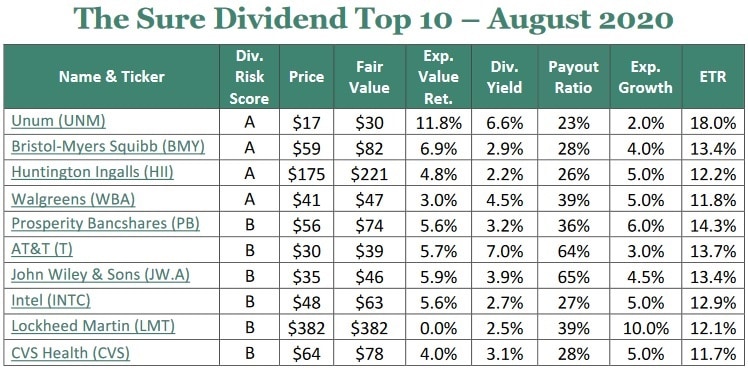
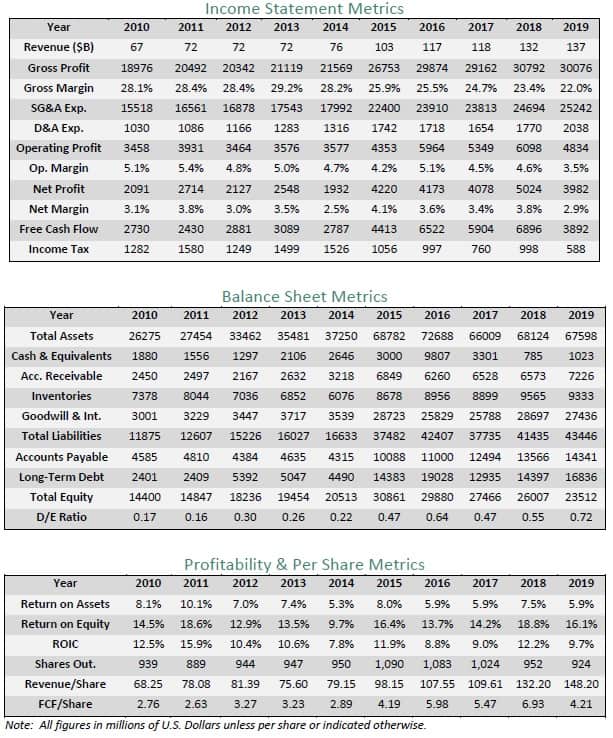
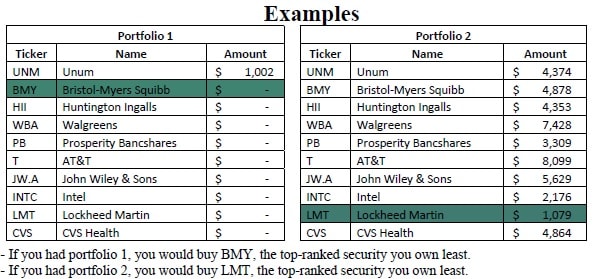
I used to get this but haven’t gittern it for a while. .I enjoyed it immensely and wish to subscribe again.,,Please advise on how I can re-subscribe,
t
Just follow click any of the links above and sign up. The links on this page will give you a slight discount. If aren’t getting the emails for which you already subscribed to, email [email protected] for help.
Love this article and recommendation